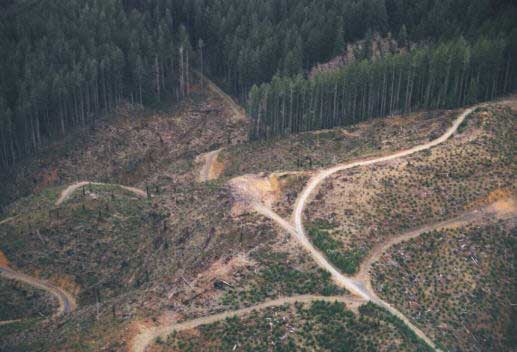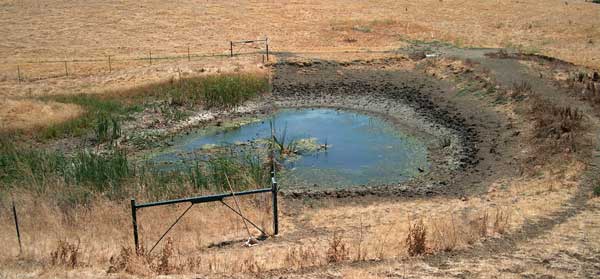Impact of Habitat Degradation
Updated January 15, 2021, Michelle Koo
Original posted May 7, 2008
Introduction
Habitat destruction, alteration and fragmentation are probably the most serious causes of current and future amphibian population declines and species extinctions (Dodd and Smith 2003). Amphibians are found in a great variety of ecosystems from tropical rainforests to arid deserts (Stebbins and Cohen 1995). The general public often perceives amphibian habitat as being confined to wetlands and other aquatic environments, but surprisingly, a large number of species are entirely terrestrial (e.g., plethodontid salamanders and eleutherodactylid frogs; for a good overview of amphibian natural history, see Stebbins and Cohen 1995). This diversity in habitat requirements between species and even between life-stages of the same species emphasizes that we can not take a simplistic approach to amphibian conservation. In order to successfully conserve amphibians, we need a clear understanding of their varied life histories and habitat requirements. There are distinct differences between habitat destruction, alteration and fragmentation. Here we briefly discuss these differences and give examples as to how these factors adversely affect amphibians.
HABITAT DESTRUCTION
Habitat destruction is defined as the complete elimination of a localized or regional ecosystem leading to the total loss of its former biological function (Dodd and Smith 2003). For example, habitat destruction is most obvious when amphibian habitat is drained, filled or cut and then converted into parking lots, housing developments or agricultural developments etc. A study by Davidson et al. (2002) found that habitat destruction due to urbanization has significantly contributed to the declines of the California red-legged frog (Rana draytonii). Although this species is usually found in or near aquatic habitats, adult frogs have been tracked moving up to 3 km over terrestrial habitat with little regard to topography. Encroaching urbanization into upland habitat, as illustrated in the picture below, may have devastating affects on adult movement and survival of this species.

Photo by John Fielder
Clearcutting alters habitats drastically and can have devastating affects on species richness and abundance. Petranka et al (1993) compared species richness and abundance of salamanders on six recent clearcuts with salamander densities in mature forest stands in the Appalachian Mountains. They found that salamander densities in the mature stands were five times higher than those in the recently cut plots. From these surveys, Petranka et al. (1993) estimated that timber harvesting in the Appalachian Mountains resulted in the loss of 14 million salamanders annually. The Food and Agricultural Organization's (FAO) (2007) biannual report gives global data on the state of the world's forest habitats(www.fao.org).

Clearcut along Oregon's Coast Range, photo by Steve Holmer
HABITAT ALTERATION
Habitat alteration are changes made to the environment that adversely affect ecosystem function, although not perhaps completely or permanently (Dodd and Smith 2003). One example is livestock grazing, a serious problem for amphibians and other organisms that occur in aquatic environments. Livestock, such as cattle can effectively trample aquatic vegetation and cause accelerated bank erosion (especially in streams)and this can result in unsuitable habitat for amphibians. The picture below illustrates the effect of cattle on ponds. Notice that half of the pond is fenced off, keeping the cattle out. The vegetation is quickly reestablishing on the half of the pond that has been fenced off from grazing cattle, but the other side, which is still heavily used by cattle is barren. Fencing off portions of a pond to exclude cattle is one amphibian friendly management technique.

© 2003 Rebecca Doubledee
HABITAT FRAGMENTATION
Habitat fragmentation is a secondary affect of habitat destruction. The primary effect being the elimination of individuals or populations from the portion of the landscape that has been destroyed, and the secondary effect, habitat fragmentation, occurs when remaining populations are isolated because the links between habitat patches have been destroyed. Many amphibian populations exhibit a metapopulation structure, populations existing as an interconnected series of populations within a larger geographic area (Marsh and Trenham 2001). Metapopulation models predict that isolated populations are more likely to go extinct in the long run than populations that are slightly connected (Hanski 1999). Over time, habitat fragmentation can lead to the loss of genetic diversity which can affect a populationís ability to respond to environmental changes, confounding the effects of climate change, contaminants and introduced species.
Wetland habitats:
- 185,400ha of wetlands lost per year between mid-1950s and mid-1970s
- 117,400 ha of wetlands lost per year between mid-1970s and mid 1980s
- 155,200 ha of wetlands lost to urbanization and rural development between 1986 and 1997.
- 70-90% loss of wetlands in Connecticut, Maryland and Ohio between 1780 and 1980.
- 69% of pocosins of Atlantic Coastal Plain destroyed by 1980.
- 50% loss of everglades ecosystem by the early 1990s; the remainder greatly altered.
- 50 to 60% loss of wetlands in Alabama between 1780 and 1980.
- 54% loss of wetlands in Michigan, Minnesota and Wisconsin.
- 30 to 36% loss of wetlands in Arizona, New Mexico and Utah between 1780 and 1980.
- 91% loss of vernal pools and wetlands from California.
- 70% loss of ponds in Britain between 1880 and 1980s
- 82% of marshlands destroyed in Essex County, England, between 1938 and 1981.
- Xenopus gilli has lost 60% of its wetland /lieeding sites in South Africa due to habitat loss.
Stream and River Habitats
- 98% of the original 5.2 million kilometers of streams in the continental United States have been seriously affected
- 91% of river lengths in lower 48 US states developed by 1988
- 33% of hydrological basins in northeastern United States affected by toxics: 63% by excess nutrients
- 66% of the riparian forest in the United States has been destroyed.
- 85 to 98% of riparian forest in Arizona and New Mexico have been destroyed or severely degraded.
Terrestrial Habitats
- 0.01% of native grasslands remain in pre-European contact condition
- 85 to 98% loss of oldgrowth forest in Blue Ridge and Cumberland Plateau provinces of Tennessee
- 69% of Illinois forests present in 1820 are gone today.
- 60% of old-growth forest on Olympic Peninsula, Washington, is in patches of 40 h or less
- 85% of coastal redwood forest reduced in California
- 0.2% of original forest remains in Puerto Rico
- Forest cover is only 13% of Cuba, 10% of the Dominican Republic, 5% of Jamaica and less than 1% of Haiti because of deforestation.
Literature Cited
Beebee, T. J. C. 1996. Ecology and conservation of amphibians. Chapman and Hall, London, UK.
Bickford, D. et al. (2008) Forgetting Habitat Loss in Amphibian Extinctions- Missing the Forest for the Disease. Accessed 4/11/2008.Cooper N, Bielby J, Thomas GH, Purvis A (2008) Macroecology and extinction risk correlates of frogs. Global Ecology and Biogeography 17(2): 211-221.
Dahl, T. E. 2000. Status and trends of wetlands in the conterminous United States 1986 to 1997. U.S. Department of the Interior, Fish and Wildlife Service, Washington, D.C. 82 pp.
Dodd, C. K., and L. L. Smith. 2003. Habitat destruction and alteration: historical trends and future prospects for amphibians. Pages 94-112 in R. D. Semlitsch, editor. Amphibian Conservation. Smithsonian Institution, Washington.
FAO (2007). State of the World's Forests. Rome: Food and Agricultural Organization of the United Nations.Hanski, I. 1999. Metapopulation ecology. Oxford University Press:i-ix, 1-313.
Hedges, S. B. 1993. Global amphibian declines: a perspective from the Caribbean. Biodiversity and Conservation 2:290-303.
Hijmans, R., et al. (2008). Worldclim. http://www.worldclim.org/ accessed 5/4/2008.
IUCN, Conservation International, and NatureServe. (2006) Global Amphibian Assessment. Mac, M. J., P. A. Opler, C. E. Puckett, and P. D. doran. 1998. Status and trends of the Nation's Biological Resources. Volumes 1 and 2. U.S. Geological Survey, Reston, VI. Marsh, D. M., and P. C. Trenham. 2001. Metapopulation dynamics and amphibian conservation. Conservation Biology 15:40-49. Petranka, J. W., M. E. Eldridge, and K. E. Haley. 1993. Effects of Timber Harvesting on Southern Appalachian Salamanders. Conserv Biol 7:363-370. Stebbins, R. C., and N. W. Cohen. 1995. A natural history of amphibians. Princeton University Press:i-xvi, 1-316. Sodhi NS, Bickford D, Diesmos AC, Lee TM, Koh LP et al. (2008) Measuring the meltdown: drivers of global amphibian extinction and decline. PLoS One 3(2): e1636. doi:10.1371/journal.pone.0001636
Stuart, S. Janice S. Chanson, Neil A. Cox, Bruce E. Young, Ana S. L. Rodrigues, Debra L. Fischman, and Robert W. Waller (2004). Status and Trends of Amphibian Declines and Extinctions Worldwide. Science 306 (5702), 1783. doi: 10.1126/science.1103538
